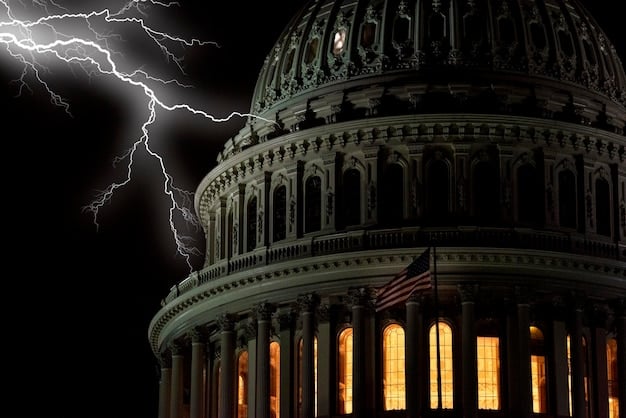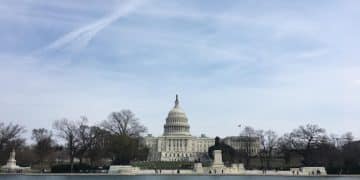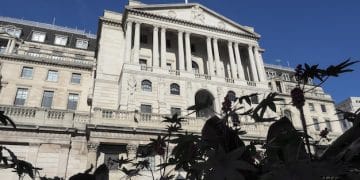Understanding the US Debt Ceiling Debate: Stakes and Outcomes

The US debt ceiling debate revolves around whether Congress will raise the legal limit on how much the federal government can borrow to meet its existing obligations, impacting everything from Social Security payments to national defense and potentially leading to severe economic consequences if not addressed.
Navigating the complexities of the US financial landscape often brings us to the critical issue of the debt ceiling. The US debt ceiling debate: what’s at stake and what are the potential outcomes? is a recurring event with significant implications for the nation’s economy and global financial stability. Understanding this debate is crucial for anyone interested in US politics and economics.
What is the US Debt Ceiling?
The debt ceiling, also known as the debt limit, is the total amount of money that the United States government is authorized to borrow to meet its existing legal obligations, including Social Security and Medicare benefits, military salaries, interest on the national debt, tax refunds, and other payments. It is essentially a credit limit for the US government. Once the debt ceiling is reached, the Treasury Department can no longer borrow additional funds, which can lead to a range of potential problems.
Historical Context of the Debt Ceiling
The concept of a debt ceiling dates back to 1917, during World War I, when Congress established a limit on the total amount of debt the Treasury could issue. This was meant to streamline the borrowing process and give the Treasury more flexibility. Over the years, the debt ceiling has been raised numerous times to accommodate the growing needs of the government. Increases in the debt ceiling do not authorize new spending; rather, they allow the government to pay for spending that Congress has already approved.
How the Debt Ceiling Differs from Budgeting
It is essential to differentiate between the debt ceiling and the federal budget. The budget outlines the government’s spending and revenue plans, while the debt ceiling is a limit on how much the government can borrow to finance existing obligations. When Congress approves a budget that anticipates spending exceeding revenue, the government must borrow money to cover the difference. The debt ceiling is the mechanism that allows this borrowing to occur.
- The debt ceiling does not authorize new spending; it only allows the government to pay its existing bills.
- Failing to raise the debt ceiling does not reduce the amount of money the government owes.
- Raising the debt ceiling simply allows the government to avoid defaulting on its legal obligations.

In summary, the debt ceiling is a critical aspect of US financial management that allows the government to meet its financial obligations. Understanding its historical context and how it differs from the budgeting process is vital for grasping the potential stakes and outcomes of the ongoing debate.
Why is the Debt Ceiling a Recurring Issue?
The debt ceiling becomes a recurring issue because the government frequently spends more than it collects in revenue, necessitating the need to borrow additional funds. This structural imbalance between spending and revenue leads to periodic debates and political brinkmanship over whether to raise the debt ceiling. These debates often become opportunities for political parties to push for their policy priorities and criticize the fiscal policies of the opposing party.
Political Polarization and the Debt Ceiling
Increased political polarization has exacerbated the debt ceiling debates. In recent years, opposing parties have used the debt ceiling as leverage to extract concessions from the White House. This can lead to prolonged negotiations, government shutdowns, and increased uncertainty in financial markets. The willingness of some politicians to risk default in pursuit of their political goals has made these debates increasingly contentious and unpredictable.
Fiscal Policy Differences
Differences in fiscal policy also contribute to the recurring nature of the debt ceiling issue. Democrats and Republicans often have divergent views on taxation, government spending, and the appropriate role of government in the economy. These differences make it challenging to reach consensus on long-term fiscal solutions, leading to repeated short-term fixes and debt ceiling crises.
Impact of Economic Conditions
Economic conditions play a significant role in shaping the debt ceiling debate. Recessions and economic downturns often lead to decreased tax revenue and increased government spending on social safety net programs, widening the budget deficit and increasing the need to raise the debt ceiling. Similarly, periods of economic growth can lead to increased tax revenue and decreased spending, but these effects are often insufficient to eliminate the need for borrowing.
- Political polarization makes it difficult to reach bipartisan agreements on fiscal policy.
- Differences in fiscal philosophy lead to ongoing disputes over taxation and government spending.
- Economic conditions can exacerbate the need to raise the debt ceiling.
In conclusion, the recurring nature of the debt ceiling issue is driven by a combination of structural fiscal imbalances, political polarization, differing fiscal philosophies, and economic conditions. Addressing these underlying factors is essential for finding a more sustainable and less contentious approach to managing the nation’s debt.
What are the Potential Consequences of Not Raising the Debt Ceiling?
Failing to raise the debt ceiling could have catastrophic consequences for the US economy and global financial system. If the government cannot borrow money to pay its existing obligations, it would be forced to default on its debts, which could trigger a financial crisis, damage the nation’s creditworthiness, and lead to a range of other negative outcomes.
Economic Recession
A default on US government debt could trigger a severe economic recession. Financial markets would likely react negatively, leading to a sharp decline in stock prices, increased borrowing costs, and decreased investment. Businesses might be forced to lay off workers, leading to higher unemployment rates and decreased consumer spending. Consumers could experience difficulty obtaining loans and mortgages, further depressing economic activity.
Disrupted Government Services
Without the ability to borrow money, the government would be forced to drastically cut spending, which could disrupt essential government services. Social Security payments, Medicare benefits, military salaries, and other federal programs could be delayed or reduced. Federal employees might be furloughed, and government agencies could be forced to scale back operations. This could lead to widespread hardship and discontent among the population.
Damage to US Creditworthiness
A default on US government debt would severely damage the nation’s creditworthiness. Investors would likely demand higher interest rates on US Treasury securities, making it more expensive for the government to borrow money in the future. This could lead to a long-term increase in the national debt and decreased fiscal flexibility. The US could lose its status as a safe haven for investors, and the dollar could depreciate against other currencies.
- Default could trigger a severe economic recession.
- Essential government services could be disrupted.
- US creditworthiness could be severely damaged.

In summary, the potential consequences of not raising the debt ceiling are dire and far-reaching. Avoiding default is essential for maintaining economic stability, protecting government services, and preserving the nation’s creditworthiness.
What are the Possible Solutions to the Debt Ceiling Issue?
Addressing the debt ceiling issue requires a combination of short-term fixes and long-term fiscal reforms. While simply raising the debt ceiling buys time, it does not address the underlying problem of structural budget deficits. Therefore, comprehensive solutions are needed to ensure fiscal sustainability and avoid future debt ceiling crises.
Increasing the Debt Ceiling with Conditions
One common approach is to raise the debt ceiling while also implementing conditions aimed at reducing government spending or increasing revenue. These conditions could include spending caps, entitlement reforms, or tax increases. Negotiating these conditions can be challenging, but it can also provide an opportunity to address long-term fiscal imbalances.
Eliminating the Debt Ceiling
Some experts have proposed eliminating the debt ceiling altogether. They argue that it is an unnecessary political tool that creates uncertainty and risks economic harm. Under this proposal, Congress would still be responsible for approving the federal budget, but the Treasury would have the authority to borrow money as needed to finance those appropriations.
Constitutional Amendment
Another potential solution is to enact a constitutional amendment requiring a balanced budget. This would force Congress to make difficult choices about spending and taxation, and it would eliminate the need for a debt ceiling. However, amending the Constitution is a complex and time-consuming process, and there is no guarantee that such an amendment would be ratified.
- Raising the debt ceiling with conditions can address fiscal imbalances.
- Eliminating the debt ceiling could reduce uncertainty.
- A constitutional amendment could enforce fiscal discipline.
In conclusion, there are several potential solutions to the debt ceiling issue, each with its own advantages and disadvantages. Finding a lasting solution requires political will, compromise, and a commitment to sound fiscal policy.
How Does the Debt Ceiling Affect the Average American?
The debt ceiling debate and its potential outcomes can have significant effects on the average American. From job security to government services and interest rates, the stakes are high for households across the country. Understanding these impacts is crucial for informed citizenship and personal financial planning.
Job Security and Employment
A debt ceiling crisis and potential default can lead to economic uncertainty, causing businesses to delay hiring or even implement layoffs. This can result in job losses and reduced employment opportunities for Americans across various sectors. The ripple effect can extend to decreased consumer spending, further impacting businesses and the overall job market.
Government Services and Benefits
Failure to raise the debt ceiling could result in disruptions to government services and benefits that many Americans rely on. Social Security payments, Medicare benefits, veterans’ programs, and other essential services could be delayed or reduced. This can create financial hardship for vulnerable populations and disrupt the social safety net.
Interest Rates and Borrowing Costs
A default or near-default situation can damage the US’s credit rating, causing interest rates to rise. This can impact the cost of borrowing for individuals, including mortgages, auto loans, and credit card debt. Higher interest rates can make it more expensive to purchase a home, finance a car, or manage existing debt, putting a strain on household finances.
- Job security is threatened by economic uncertainty during debt ceiling crises.
- Government services and benefits could be disrupted, affecting vulnerable populations.
- Interest rates may rise, increasing borrowing costs for individuals and families.
In summary, the debt ceiling debate’s impact on the average American is multifaceted, affecting job security, access to government services, and the cost of borrowing. Staying informed and understanding these potential consequences is crucial for safeguarding personal financial well-being.
Recent Developments and Future Outlook
The US debt ceiling continues to be a subject of discussions and negotiations in Washington. Recent developments and future outlooks indicate that this debate is far from over. Understanding the political dynamics and potential scenarios is essential for anticipating the future trajectory of this issue.
Current Political Landscape
The current political landscape significantly influences the debt ceiling debate. With a divided government, reaching a consensus on fiscal policy becomes even more challenging. Differing views between the executive and legislative branches, as well as within Congress, can lead to protracted negotiations and potential standoffs.
Potential Scenarios and Outcomes
Several potential scenarios could unfold in the coming months. These range from a negotiated agreement to raise the debt ceiling with certain conditions, to a temporary extension of the debt limit, or even a failure to reach an agreement, leading to potential default. The likelihood and impact of each scenario depend on the willingness of political leaders to compromise.
Long-Term Fiscal Sustainability
Addressing the debt ceiling issue requires a focus on long-term fiscal sustainability. This involves implementing policies that promote economic growth, control government spending, and ensure a balanced approach to taxation. Sustainable fiscal policy is essential for maintaining the US’s economic strength and avoiding future debt ceiling crises.
- The current political landscape influences the debt ceiling debate.
- Potential scenarios range from negotiated agreements to potential default.
- Long-term fiscal sustainability is essential for avoiding future crises.
In conclusion, the US debt ceiling remains a complex and evolving issue with significant implications for the economy and the average American. Staying informed about recent developments and potential outcomes is crucial for understanding the future trajectory of this debate.
| Key Point | Brief Description |
|---|---|
| 💰 Debt Ceiling Definition | The total amount the US government can borrow to meet existing legal obligations. |
| 📈 Consequences of Default | Economic recession, disrupted government services, and damaged US creditworthiness. |
| 📜 Potential Solutions | Increasing with conditions, eliminating the ceiling, or a constitutional amendment. |
| 👨👩👧👦 Impact on Americans | Affects job security, government benefits, and borrowing costs for households. |
Frequently Asked Questions
The debt ceiling was first established in 1917 during World War I to streamline the government’s borrowing process. It allowed the Treasury to have more flexibility in managing the nation’s finances during the war.
Raising the debt ceiling does not authorize new spending. It simply allows the government to pay for obligations already approved by Congress. It prevents the US from defaulting on its existing debts.
If Congress fails to raise the debt ceiling, the US government could default on its obligations. This could lead to a financial crisis, economic recession, and damage to the nation’s creditworthiness.
Yes, some experts have proposed eliminating the debt ceiling to reduce uncertainty and avoid potential economic harm. They argue that it is an unnecessary political tool that creates financial instability.
The debt ceiling debate can impact the average citizen through job security, government services, and interest rates. Economic uncertainty can cause businesses to delay hiring, while disruptions to government services can affect vulnerable populations.
Conclusion
The US debt ceiling debate is a critical issue with profound implications for the nation’s economy and the financial well-being of its citizens. Understanding the stakes, potential outcomes, and possible solutions is essential for informed participation in the political process and for making sound financial decisions. As the debate continues to evolve, staying informed and engaged is more important than ever.





